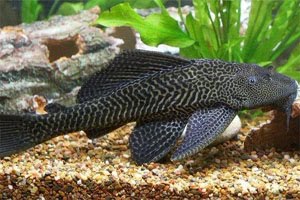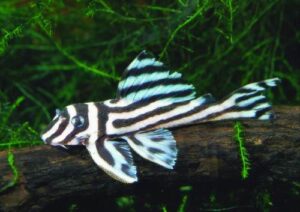
Throughout the years that I’ve been in the aquarium industry, I’ve seen a lot of people try desperately to find animals that will keep their freshwater or marine tanks clean so that they can avoid manually scraping algae or combating one of many possible nuisance infestations. The truth is, algae problems and other nuisance infestations can rarely, if ever, be solved by animals. Human intervention is almost always the answer. This post is part of a series in which I hope to illustrate the importance of proper maintenance and water care by pointing out the shortcomings of the most common animals people use to attempt to “solve” aquarium problems.
Want to avoid scraping algae for the rest of your life?
We’re putting together an easy-to-use guide –
“From Gross to Gorgeous: How to Easily Manage Algae in Your Aquarium (Without Putting the Fish at Risk)”.
Interested in getting this when it’s ready?
Plecos: Fish that clean the tank?
Algae is a problem that all aquarists have to deal with it at some point. Keeping an aquarium looking clean and free of algae is most often an ongoing battle. You may even have searched for fish that clean the tank. In freshwater aquariums, “Plecos” (short for plecostomus and used to refer to fish of the family Loricariidae) are one of the most common fish purchased to aid in algae cleanup. The reality is, unless you have an aquarium larger than 75 gallons and only one Pleco, the Plecos will end up feasting mainly on the meat based foods that you feed your other fish. This is because there is rarely enough algae growth in an aquarium to sustain a Pleco’s appetite. Further, a high-protein diet based primarily on meaty foods can be unhealthy for animals who have a digestive system intended to process mostly plant matter.
On the other hand, even if you do have a large tank and enough algae, Plecos are not capable of scraping the algae completely away from any surface in the tank, including the glass, so you will always be left with a thin, but noticeable, coating of algae. This seemingly faulty cleaning ability might be a genetic development to prevent the fish from completely eliminating their own food sources. When a little is left behind, the algae will grow back, providing a sustainable food source for the algae eaters. However, if the algae were completely scraped away, it might not grow back, forcing the algae eaters to find a new source of food.
This does not mean you should never buy a Pleco though. Some Plecos are truly stunning and there are literally hundreds of species of Plecos for aquarists to purchase. Just remember that you must provide them with a vegetable-based food, especially in smaller tanks with little algae growth. It is also important to know that some of the most common species of Plecos can reach lengths of 24″ or more, and they are very powerful swimmers capable of knocking over decorations and stirring up your substrate with the flick of a tail. Finally, if you have a planted tank and are searching for algae eaters, only purchase Plecos if you are familiar with the species and its dietary requirements. Otherwise you may end up with a fish that will eat your plants.

If you do want a Pleco that will aid in algae removal, the Bushy Nosed (Bristle Nosed) Plecos from the genus Ancistrus seem to do the best job and most tend to stay pretty small. Just remember that the fish will not solve your algae problems. Proper maintenance of the aquarium and its water parameters are the only solution. My advice is to purchase Plecos because you like the way they look, not to keep your tank clean, and to research that particular species’ food requirements. Most Plecos are omnivorous but require a diet high in vegetation. Some prefer soft vegetation, while others like to rasp on wood. There is also at least one species, the coveted Zebra Pleco, which lives primarily on meaty foods.

Great advice. I got carried away with my aquarium and bought a pleco. I love Henry but he spends his time hiding. I gave him 2 terra cotta flower pots. He was hanging out in a corner behind the plants and filter. Our aquarium has been a nice diversion from all the chaos.
I have 3 tanks with 4 generations of green anubius Cory cats. I bought new plants from the pet store and a clown pleco hitched a ride to my house. It now lives in a 20 gallon fish rank with 7 cories. I’m feeding him (or her) pleco wafers that have zucchini in them. I will get a nice piece of driftwood for it soon as I’ve read they like to hide and will eat it. He’s really cute and the cories are fascinated by their new tank mate. The pet store told me they don’t really need another pleco bud and that they’re solitary. What do you think about that? Is that right?
Shortly after getting my plecos, my catfish disappeared. Would he have eaten the catfish
D, it’s not likely the pelvis killed the cat fish but they would probably have eaten the remains after it died.
Question: is this pleco okay?
About 12 years ago, I inherited a pleco from a student who couldn’t keep it anymore. It is about 18 years old. It’s healthy and active, but water remains murky, even with frequent partial water changes and vacuuming gravel. He eats only algae wafers and is approx. 12 in long in a 30 gal tank. I can’t do a 75 gal tank that might be better.
Denise, Your aquarium is too small for that fish. The murky water may indicate poor water quality and you should test for pH, ammonia, nitrite and nitrate. You could try using a bigger/better filter to correct the water quality issues but a 12” pleco needs more room to move about.
the water that’s flowing from my sponge filter looks clear,but was does the aquarium water look cloudy?
Ruth, it’s likely you have a bacteria bloom in your aquarium. Did you set it up recently?